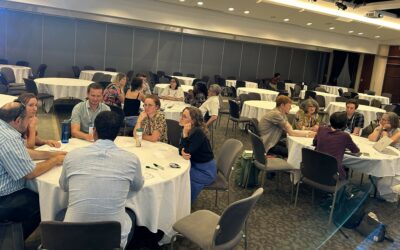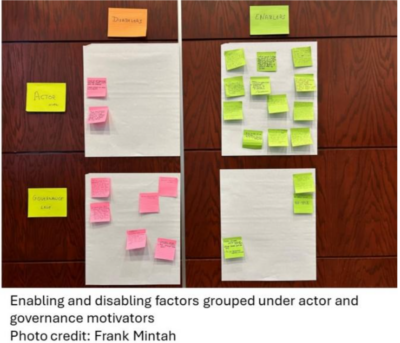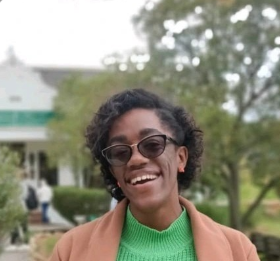Why would you work with others?… addressing social-ecological dilemmas at landscape level through collaboration
Written by Frank Mintah and Edited by Sungeni Karonga Photo by Frank Mintah

This blog post is part of a series reflecting on a selection of sessions and keynotes that were presented at the PECS-III Conference, Montreal Canada, 12-15 August 2024
The opportunity to work with different people can be both inspiring and challenging. Collaboration is recognised as an important way of addressing social-ecological problems through exchanging ideas, experiences, skills and resources. However, the factors that motivate actors to collaborate are not always clear. Dr. Francis Turkelboom (chair of the session) challenged the audience in this innovative session to ponder: Why would I work with others? Motivations for collaboration at landscape level.
Learning from a collaboration role-play
The session used experiential learning through a role-playing game to better understand the factors that motivate people to work together. The audience was grouped into teams of six, with each member taking on a new persona of either protected landscape manager, dairy farmer, retired landlord, nature conservation NGO coordinator, bread and breakfast business owner, or mayor. The scene was a virtual quaint town called Midland Hill in the countryside, with villages, dairy farms, heritage sites, rich biodiversity and beautiful sceneries. The park attracts tourists, which can facilitate local economic development. On the other hand, the gradual intensification of dairy farms and the conversion of grassland to arable land, is causing erosion and mudflows, biodiversity loss and decline of the typical landscape. The groups were challenged to imagine a scenario in which a park manager sought to create a coalition that is expected to work together to maintain and improve the protected landscape park and to develop actions that will enable a resilient landscape by 2050. The groups worked under different governance regimes: self-organised local coalition (bottom-up), autocratic (top-down) and a co-design of government agencies and local actors.

The role play showed that our values, interests and positions influence how we show up in collaborative spaces. These interests and positions are mostly conflicting, bordering on priorities for livelihoods, nature conservation or economic benefits. For instance, for the farmer, safeguarding his rural livelihood was a major concern; for the retired landowner, maintaining his private land and a peaceful environment; for the NGO coordinator, extending biodiversity conservation; and for the mayor, realising the economic potential of a park was important. In addition, the nature of the intervention and perceived impacts – either positive or negative – influences actors’ behaviour.
So, what motivates us to collaborate, even when our interests are diverse?
The session showed how actor and governance motivators are important in promoting collaboration. The actor’s motivations included non-material relations to nature and place attachment due to historical relations. These are intrinsic values embedded in the multiple ways through which people relate to nature for spiritual, cultural and well-being purposes. In effect, they may experience a sense of duty to protect the landscape, hence their willingness to collaborate. Also, the presence of community cohesion, mutual trust, and a feeling of interdependency are some inherent group characteristics that can motivate people to work together. These help to create a network of social relations that shape collective visions and actions. Oftentimes, the expected material or livelihood benefits, including financial gains, also serve as a source of motivation.
People can also be motivated externally to work together through supportive governance institutions that facilitate negotiations of varying interests, consensus building and alignment of goals. Institutional designs that provide equal participation of all actors, especially the most vulnerable, ensure that each stakeholder has a voice in decision-making and that the decisions made reflect the collective interest. As evident from the role-play, the group with a democratic bottom-up structure had more people willing to collaborate. This should also be accompanied by structures for accountability and evidence of concrete achievement towards collective goals to avoid drop-out. Both governance and actor motivators are shaped by biophysical, political, socio-economic and cultural context factors, which may hinder or enhance collaborative processes.
Reflections and takeaways
The factors that motivate collaborations are very actor and context-dependent, and they influence each other in many ways. It is important to consider what the goal of the intended collaboration is, who the actors are, as well as the process and terms of collaboration. In doing this, the role of power need not be neglected. People’s worldviews and discursive power can highly influence the results of collaborations. Power dynamics may lead to polarization or alienation of other actors. This makes the design of the collaborative process itself and spaces very critical. Governance designs that enhance local self-organisation, as well as relational values to landscapes, are important in promoting successful collaborations.
Session chair: Francis Turkelboom: https://www.researchgate.net/profile/Francis-Turkelboom
PECS Working Group: https://pecs-science.org/navigating-trade-offs-and-synergies-between-biodiversity-and-society-in-protected-multifunctional-landscapes/


